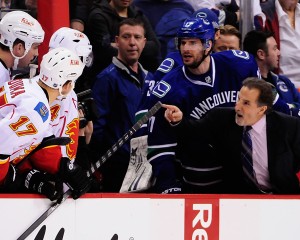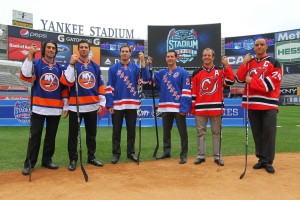The 2013-2014 NHL season, just as the seasons before it, has included its fair share of suspensions. This season has racked up 24 total suspensions thus far, adding up to almost 100 games missed by the offending players (96 games as of 01/25/2014). The implementation of suspensions draw publicity, and as the NHL seeks to sustain a growing fan base, the future might hold different consequences for offending parties.
The NHL has recently gained mainstream media attention for the face-off brawl that occurred between the Vancouver Canucks and Calgary Flames. This incident led to Vancouver head coach John Tortorella’s 15-day suspension and Calgary head coach Bob Hartley receiving hefty fines. Hartley’s $25,000 fine was cited by the National Hockey League by-law 17 entitled “Fines, Suspensions, and Expulsions.” To be exact, this citation was in reference to Section 17.3a, which addresses conduct that is “dishonorable, prejudicial to or against the welfare of the League.”

Thanks to the Phoenix Coyotes team almost succumbing to bankruptcy back in 2009, the NHL’s Constitution and By-Laws became public record. After looking into Hartley’s suspension, I found myself thinking, how many times has by-law 17 been applied in suspensions? It seems that any type of altercation that would shine a negative light on the NHL could be deemed as going against the “welfare of the League” – potentially opening up the possibility for greater fines in the future.
Remember when Sean Avery used to date Dion Phaneuf’s wife? Back in 2008, Avery was smacked with an “indefinite” suspension after making remarks about his ex-girlfriend, actress Elisha Cuthbert. Not surprisingly, the NHL cited by-law 17 in this incident. So when else could the NHL implicate by-law 17?
Recall this past December when there was an incident involving Boston Bruins forward Shawn Thornton and Pittsburgh Penguins defenseman Brooks Orpik. The incident led to Orpik being out of the lineup for 8 games after sustaining a concussion and Thornton was suspended 15 games for “punching an unsuspecting opponent” (the ruling falling under Playing Rules 28, 46.15, and 21.1).
Although some believe Thornton’s punishment to be fair, one could argue, however, that Thornton’s behavior was an embarrassing representation of the League and could additionally be cited under by-law 17.
After reviewing the suspensions of the 2013-2014 season, it is clear that most suspensions were results of in-game plays involving hits to the head (8 suspensions) and boarding (8 suspensions), leaving only a minority of suspensions that included more intentional or malicious conduct. We are left with incidents such as James Neal’s suspension for “kneeing” and Brad Stuart’s suspension for “elbowing” — plays that, much like Thornton’s incident, could easily be associated with conduct that is “dishonorable or against the welfare of the League.”

Typically, hockey games are not covered by mainstream media when a team is winning games, but rather when there are clear acts of violence. As I’m sure many fans can attest, the image of the NHL to laypersons is often associated with violence. Is this violent image defaming the NHL’s public image? Future enforcement of by-law 17 could be used to send a message similar to the new(er) rules regarding hits to the head. If we are fighting to curb concussions, shouldn’t we also be fighting to curb intentional injuries that negatively portray the sport as a whole?
The NHL has obviously been trying to attract new fans and increase revenue by building momentum up to the Stadium Series this season. If the League is willing to take on beach volleyball and a KISS concert, I imagine they may be willing to fine players more often to upkeep the image of the National Hockey League and to attract a wider demographic of fans.